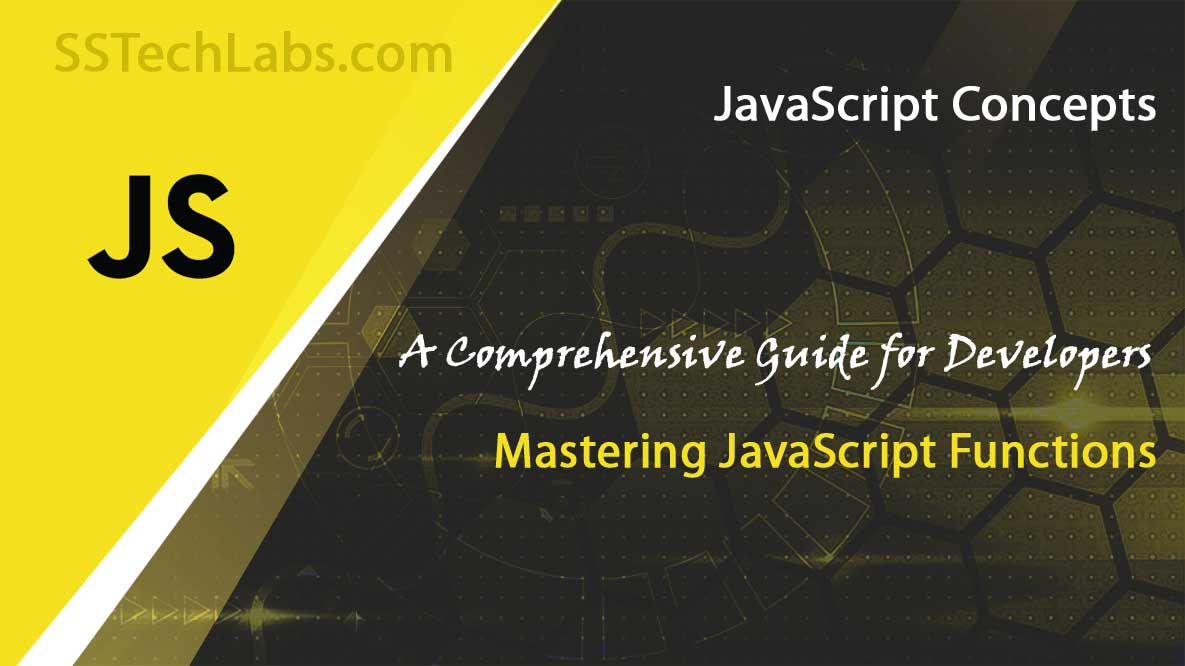Introduction
Functions are the key parts of a program. They let you use the same code multiple times without having to write it again. A JavaScript function is a set of instructions meant to do a specific job. It runs when it is called by something.
A function acts like a procedure, which is a series of statements that carry out a task or compute a value. However, for a procedure to be considered a function, it needs to accept input and provide output, showing a clear link between the two. To use a function, you need to define it in the area where you want to call it. This article “Mastering JavaScript Functions” is a comprehensive guide for developers to develop applications.
Function Declaration
A function definition (also called a function declaration, or function statement) consists of the function keyword, followed by:
- The function’s name.
- A set of parameters for the function, placed in parentheses and divided by commas.
- The JavaScript code that makes up the function, placed in curly braces, { /* … */ }.
Types of Functions in JavaScript

1. Named Function
Named functions are functions that come with a specific name. They are created using the function keyword and then the function name. Named functions are great for reusing code and for debugging because their names show up in stack traces, which helps in finding problems. The name of the function is stored in the body, which is useful. Additionally, we might use the name to get a function to call itself or to acquire its characteristics, just like we would for any object.
Example:
function sum(a, b){
return a + b;
}
sum(2, 3);2. Anonymous Function
The term “anonymous” refers to something that is unidentified or unknown. An anonymous function in JavaScript is one that has no name, or, to put it another way, is nameless. An anonymous function is declared without an identifier when it is created. It’s the distinction between an anonymous function and a regular function. Not specifically in JavaScript, but in a number of other programming languages as well. An anonymous function plays the same role.
Example:
let abc = function () {
console.log('This is a anonymous function');
};
abc(); 3. Function Expression
A function* expression is very similar to, and has almost the same syntax as, a function* declaration. The main difference between a function* expression and a function* declaration is the function name, which can be omitted in function* expressions to create anonymous functions. A function* expression can be used as an IIFE (Immediately Invoked Function Expression) which runs as soon as it is defined.
Function Expression Hoisting
Function expressions in JavaScript are not hoisted, unlike function declarations. You can’t use function expressions before you create them:
4. Arrow Functions
Arrow functions are a concise way to write functions in JavaScript. Introduced in ES6, they use the => syntax and provide a shorter syntax compared to traditional function expressions. Arrow functions automatically bind this to the surrounding context, making them especially useful in callbacks and methods where maintaining the correct this context is crucial.
Example:
const greet = (name) => `Hello, ${name}!`;
console.log(greet("John")); // Output: Hello, John!
Immediately Invoked Function Expressions (IIFE)
An IIFE (Immediately Invoked Function Expression) is a function that runs as soon as it is defined. It is enclosed in parentheses to ensure it is treated as an expression and is immediately executed with another set of parentheses. IIFEs are often used to create a private scope, avoiding polluting the global namespace and protecting variables from being accessed or modified outside the function.
Example:
(function () {
console.log("This is an IIFE!");
})();Callback Functions
A callback function is a function passed as an argument to another function, allowing it to be executed later, typically after a specific task or event has completed. Callback functions are a core feature of JavaScript, especially in asynchronous programming, such as handling API calls or event listeners.
Example:
function fetchData(callback) {
setTimeout(() => {
console.log("Data fetched");
callback();
}, 1000);
}
function processData() {
console.log("Processing data...");
}
fetchData(processData);Higher-Order Functions
A higher-order function is a function that either takes one or more functions as arguments, returns a function, or both. They are a key concept in functional programming and enable more abstract and flexible code by operating on other functions.
Example:
function higherOrder(fn) {
return fn(5);
}
function square(num) {
return num * num;
}
console.log(higherOrder(square)); // Output: 25Function Parameters and Arguments
Function parameters are placeholders defined in the function declaration to represent values the function expects to receive. Arguments are the actual values passed to the function when it is invoked. Parameters act as variables within the function, while arguments are the real data provided by the caller.
Example:
function greet(name, age) { // Parameters: name, age
console.log(`Hello ${name}, you are ${age} years old.`);
}
greet("Alice", 25); // Arguments: "Alice", 25Function Scope and Closures
Function Scope refers to the accessibility of variables defined inside a function. Variables declared within a function are only accessible within that function, ensuring they don’t interfere with variables in other scopes.
Closures occur when a function “remembers” the variables from its lexical scope even after the outer function has finished executing. This allows nested functions to access and manipulate variables from their parent scope.
Example:
function outer() {
let count = 0; // Variable in the outer function's scope
return function inner() {
count++;
return count;
};
}
const counter = outer();
console.log(counter()); // Output: 1
console.log(counter()); // Output: 2Recursive Functions
A recursive function is a function that calls itself during its execution to solve a problem. Each recursive call works on a smaller subproblem, and the recursion continues until it reaches a base case, which stops further calls.
Recursive functions are commonly used for tasks like calculating factorials, solving mathematical problems, or working with hierarchical data structures such as trees.
Example:
function factorial(n) {
if (n === 0) { // Base case
return 1;
}
return n * factorial(n - 1); // Recursive call
}
console.log(factorial(5)); // Output: 120Function Hoisting
Function hoisting is a JavaScript mechanism where function declarations are moved to the top of their scope during the execution phase, allowing you to call a function before it is defined in the code. This behavior applies only to function declarations, not function expressions or arrow functions.
Example:
sayHello(); // Output: Hello, World!
function sayHello() {
console.log("Hello, World!");
}Functions Best Practices
Function Best Practices in JavaScript focus on writing clean, efficient, and maintainable functions. These practices include keeping functions small and focused (single responsibility), using descriptive names, avoiding side effects, and ensuring functions are reusable. Additionally, best practices encourage proper use of parameters and return values, consistent handling of errors, and leveraging built-in functions when possible. By adhering to these guidelines, developers can improve code readability, reduce bugs, and create scalable applications.
Common Use Cases of Functions
Functions in JavaScript are versatile and can be used in a variety of scenarios. Some common use cases include:
- Code Reusability: Functions allow you to write reusable code blocks, reducing redundancy and promoting DRY (Don’t Repeat Yourself) principles.
- Event Handling: Functions are used to handle events, such as clicks, form submissions, or key presses, in web development.
- Data Transformation: Functions can process data, such as filtering, mapping, or sorting arrays and objects, to modify or transform them as needed.
- Asynchronous Operations: Functions are essential for handling asynchronous tasks, such as making API requests, managing timers, or handling user interactions asynchronously with callbacks, promises, or async/await.
- Modularization: Functions help break large applications into smaller, more manageable pieces, improving maintainability and readability.
- Callback Functions: Functions can be passed as arguments to other functions to execute once a specific action is completed, such as in sorting or handling asynchronous data.
- Functional Programming: Functions are central to functional programming techniques, like currying, closures, and higher-order functions, to create cleaner, more declarative code.
Faq’s
What is a function in JavaScript?
- A function is a block of reusable code designed to perform a specific task. It can take inputs (parameters), perform operations, and return a result.
How do you define a function in JavaScript?
- You can define a function using the
functionkeyword followed by the function name, parameters, and body.
What are parameters and arguments in a function?
- Parameters are the names listed in the function definition (placeholders for data). Arguments are the actual values passed to the function when it is called.
What is the difference between a function declaration and a function expression?
- A function declaration defines a function with a name, and it is hoisted, meaning it can be called before it appears in the code.
- A function expression defines a function as part of an expression and is not hoisted.
What are anonymous functions?
- An anonymous function is a function that does not have a name, often used as a function expression or a callback.
What are higher-order functions?
- A higher-order function is a function that either takes one or more functions as arguments, returns a function, or both. Example:
map(),filter(), andreduce().
What is a callback function?
- A callback function is a function that is passed as an argument to another function and is executed after a certain event or operation is completed.
What is a closure in JavaScript?
- A closure is a function that retains access to its lexical scope, even when the function is executed outside of that scope. It is created when a function is defined inside another function.
What does the this keyword refer to in a function?
- The
thiskeyword refers to the context in which the function is called. Its value depends on how the function is invoked (global object, object method, or constructor).
What is the purpose of return in a function?
- The
returnkeyword is used to send a result from a function back to the caller. It terminates the function’s execution and returns a value.
What is function hoisting?
- Function hoisting refers to the behavior where function declarations are moved to the top of their scope during the compilation phase, allowing them to be called before they appear in the code.
Can a function have multiple return statements?
- Yes, a function can have multiple
returnstatements, but only one will execute depending on the flow of control. Once areturnstatement is executed, the function exits.
What is recursion in functions?
- Recursion occurs when a function calls itself within its own body. It is useful for solving problems that can be broken down into smaller, similar subproblems.
What is the difference between null and undefined when passed to a function?
nullis a value that represents the intentional absence of an object, whileundefinedmeans a variable or parameter has been declared but not yet assigned a value.
Can a function be passed as an argument to another function?
- Yes, functions are first-class citizens in JavaScript, meaning they can be passed as arguments to other functions, returned from functions, and assigned to variables.
Conclusion
In conclusion, functions are a fundamental concept in JavaScript and programming in general. They enable code reusability, modularity, and maintainability by allowing developers to group related instructions into self-contained blocks. Functions can perform a variety of tasks, including handling events, transforming data, managing asynchronous operations, and facilitating functional programming techniques. By understanding how to define, call, and optimize functions, developers can create more efficient, readable, and scalable applications. Mastering function-related concepts such as closures, callbacks, higher-order functions, and recursion is essential for becoming a proficient JavaScript developer.
Resources:









